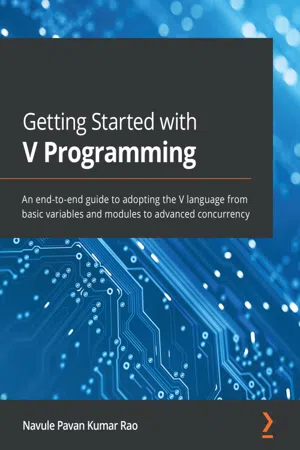
- 408 pages
- English
- ePUB (mobile friendly)
- Available on iOS & Android
Getting Started with V Programming
About this book
Learn a new statically compiled programming language to build maintainable and fast software with the help of this comprehensive guide to V programmingKey Features• Explore the features of the V programming language step by step with this beginner's guide• Gain strong foundational knowledge of core programming concepts such as modules, functions, and structs• Learn how to write super-fast programs and applications that compile in a matter of secondsBook DescriptionA new language on the block, V comes with a promising set of features such as fast compilation and interoperability with other programming languages. This is the first book on the V programming language, packed with concise information and a walkthrough of all the features you need to know to get started with the language. The book begins by covering the fundamentals to help you learn about the basic features of V and the suite of built-in libraries available within the V ecosystem. You'll become familiar with primitive data types, declaring variables, arrays, and maps. In addition to basic programming, you'll develop a solid understanding of the building blocks of programming, including functions, structs, and modules in the V programming language. As you advance through the chapters, you'll learn how to implement concurrency in V Programming, and finally learn how to write test cases for functions. This book takes you through an end-to-end project that will guide you to build fast and maintainable RESTful microservices by leveraging the power of V and its built-in libraries. By the end of this V programming book, you'll be well-versed with the V programming language and be able to start writing your own programs and applications.What you will learn• Become familiar with the basic building blocks of programming in the V language• Install the V language on various operating systems• Understand how to work with arrays and maps in V programming• Discover how to implement concurrency in V programming• Use channels in V programming to learn the best practices of sharing memory by communicating among coroutines• Write modular code and build on your knowledge of structs and functions in V• Get acquainted with writing tests in V programming• Get to grips with building and querying RESTful microservice in VWho this book is forWhether you're a beginner interested in learning a programming language or an experienced programmer looking to switch to a new and better statically compiled programming language, this V programming book is for you.
Frequently asked questions
- Essential is ideal for learners and professionals who enjoy exploring a wide range of subjects. Access the Essential Library with 800,000+ trusted titles and best-sellers across business, personal growth, and the humanities. Includes unlimited reading time and Standard Read Aloud voice.
- Complete: Perfect for advanced learners and researchers needing full, unrestricted access. Unlock 1.4M+ books across hundreds of subjects, including academic and specialized titles. The Complete Plan also includes advanced features like Premium Read Aloud and Research Assistant.
Please note we cannot support devices running on iOS 13 and Android 7 or earlier. Learn more about using the app.
Information
Section 1: Introduction to the V Programming Language
- Chapter 1, Introduction to V Programming
- Chapter 2, Installing V Programming
Chapter 1: Introduction to V Programming
- The past, present, and future of V
- V is a statically typed and compiled programming language
- Simple and maintainable syntax
- Backward compatibility, stability, and easy to upgrade to future versions
- Features of V programming
- V as a framework
- Operating systems V supports
The past, present, and future of V
V is a statically typed and compiled programming language
Statically typed versus dynamically typed
Compiled versus interpreted languages
Simple and maintainable syntax
Table of contents
- Getting Started with V Programming
- Contributors
- Preface
- Section 1: Introduction to the V Programming Language
- Chapter 1: Introduction to V Programming
- Chapter 2: Installing V Programming
- Section 2: Basics of V Programming
- Chapter 3: Variables, Constants, and Code Comments
- Chapter 4: Primitive Data Types
- Chapter 5: Arrays and Maps
- Chapter 6: Conditionals and Iterative Statements
- Chapter 7: Functions
- Chapter 8: Structs
- Chapter 9: Modules
- Section 3: Advanced Concepts in V Programming
- Chapter 10: Concurrency
- Chapter 11: Channels – An Advanced Concurrency Pattern
- Chapter 12: Testing
- Chapter 13: Introduction to JSON and ORM
- Chapter 14: Building a Microservice
- Other Books You May Enjoy